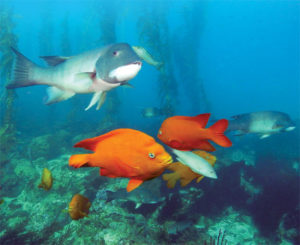 California reefs are full of fascinating critters adorned in living color. Our fish are among the most colorful and interesting and as conspicuous as they may be, many divers see only a fraction of the fish in residence. Here are a few tips to see more fish
California reefs are full of fascinating critters adorned in living color. Our fish are among the most colorful and interesting and as conspicuous as they may be, many divers see only a fraction of the fish in residence. Here are a few tips to see more fish
10) Stay off the bottom. Divers who swim on or right off the bottom kick up a little silt and break many of the reef creatures they came to see. This ruckus also scares every reef creature with a touch of self-preservation instinct either away or back into the reef. Try swimming off the bottom and observe the reef from a distance, and then get close to the fish that attract your attention.
9) Be as quiet as you can. Sound travels particularly well in water, and fish have evolved excellent sound/vibration senses. Breathe smoothly, not erratically, and select a quiet regulator. Position your weightbelt or other metal objects so they don’t bang on your tank. Don’t use sounds to attract or communicate with your buddy.
8) Don’t look that fish in the eye. Throughout the animal world direct eye contact is universally regarded as a sign of aggression. Look at your fish from the corner of your eye. The fish will allow you approach closer and they will hang with you longer.
7) Try approaching fish from a tangential path and not head on. Sometimes the direct approach is the best plan, but not with fish. A direct path tells the fish he is on your menu. You will get much closer by taking an indirect path to your fish.
6) Avoid big groups. All divers cause some disturbance and scare fish regardless of how well they behave. When a herd of divers moves across the reef, only the first few see any fish. A single buddy team is of much less concern to the local fish than a big group.
5) Look behind you. How many divers miss the (fill in your favorite, rare, large fish) when they are looking at a little blenny. Regularly do a visual sweep of your surroundings to see who is watching you.
4) Don’t chase that fish. Fish watchers who chase fish only see tails. If a fish swims away let it go and look for another. Let the fish come to you. This requires a bit of patience, but if you behave in a non-threatening way many fish will be curious and approach you. Also, fish often exhibit repeat behavior. The fish you think is swimming away may be just be making its way around a rock or coral head. Try swimming the opposite direction around the rock to meet the fish head on.
3) Run out of film/batteries/memory. Ever notice how many more fish you see when your camera no longer works? Could it be you stop behaving like a predator when your “gun” is out of “ammo”? If you behave as relaxed when your camera works as when it doesn’t, you will see and photograph more fish.
2) Become part of the reef by sitting in one place. No mater how quiet and unobtrusive you are, every diver entering an area is regarded by the local fish as a newcomer, and most are afraid of newcomers. Try kneeling in a sandy patch and breathe quietly. After ten or so minutes the fish will regard you as part of the reef and go about their business as if you are not there.
1) Bring along something to attract your favorite fish. No, I’m not talking about fish food. An orange colored glove will drive a garibaldi wild, as will placing a sea star on their nest. Try bringing a mirror with you. Some creatures are enamored with their reflections, or will regard their reflection as an interloper in their territory and try to drive their reflection away.
Try a few of these tips on your next dive, and I guarantee you will see more fish and get closer to those you do see. The final suggestion is to dive more. The more time you spend in the water the more you will see. Happy watching!









